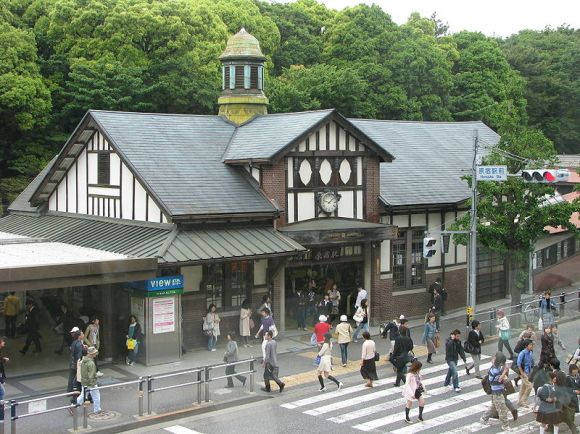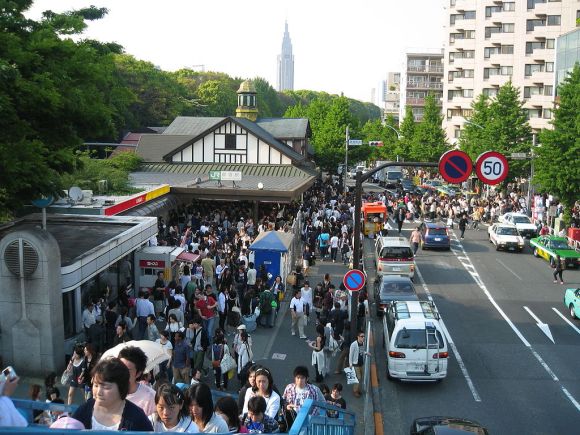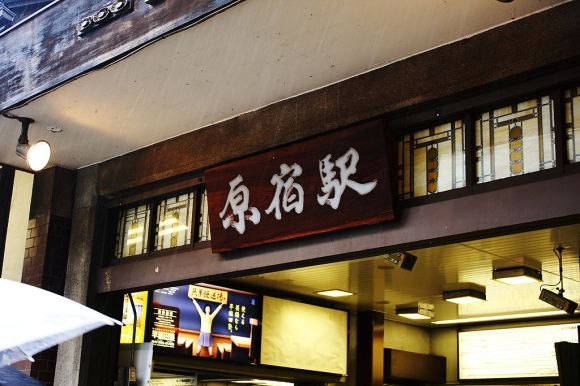
East Japan Railway Company today released images of new building designs planned for three stations on two of the city’s popular train lines.
JR East confirmed reports today that it would be renovating three stations on its Tokyo rail network, with upgrades planned for Harajuku Station on the Yamanote loop line and Sendagaya and Shinanomachi stations on the company’s Chūō-Sobu Line. The works, which will include the introduction of new barrier-free facilities and expansion of concourses and ticket gates, are expected to be completed by 2020 at a total cost of 250 billion yen (US$2.3 billion).
The new plans are designed to improve passenger flow, which is expected to increase dramatically during the 2020 Tokyo Olympics and Paralympics, and alleviate congestion, which, especially in the case of Harajuku Station, can prove dangerous as passengers spill out onto the road from the narrow walkway during peak periods on weekends and public holidays.
The new design planned for Harajuku Station involves the construction of a modern-looking two-storey building above the existing tracks. The temporary platform currently used to accommodate large numbers during special events like New Year’s Day, will now become a new platform for the outer tracks, while a new entrance will be built on the Meiji Jingu side of the station.
Inside, there will be a brand new, wider concourse and ticket gate area, along with elevators and new, more spacious amenities.
▼ The building plan sets out the changes in more detail.
The new-look Sendagaya Station, located close to the National Stadium and Tokyo Gymnasium, will convert an existing temporary platform into a permanent structure for the exclusive use of Shinjuku-bound trains.
Ticket gates will be relocated to accommodate the change and improve passenger flow while doors on platform barriers will be improved to increase security. There will also be upgrades to elevators and amenities.
Shinanomachi Station will receive new doors on platform barriers and new amenities and elevators.
Following the announcement of the station upgrades, Japanese television news reports focused heavily on the changes planned for Harajuku Station. Built in 1924, the wooden building is the oldest of its kind in the Tokyo area, and has a distinctive facade that evokes an atmosphere of nostalgia within its modern environment.
▼ JR East has said it will make a decision on whether to demolish the current structure or incorporate it into the new design after listening to views from the local municipality.
While the new plans will provide much-needed improvements to passenger flow ahead of the 2020 Tokyo Olympics and Paralympic Games, many people in Japan will be sad to say goodbye to the old building if it does have to go.
Follow Oona on Twitter for more information on news and events in Tokyo.
Source: East Japan Railway Company
Top Image: Wikimedia Commons/Chris 73
Insert Images: East Japan Railway Company








 Harajuku Station will be demolished after the Tokyo Olympics and Paralympics
Harajuku Station will be demolished after the Tokyo Olympics and Paralympics Japanese artists anthropomorphise national flags into samurai characters for 2020 Tokyo Olympics
Japanese artists anthropomorphise national flags into samurai characters for 2020 Tokyo Olympics Shinkansen will require reservations for large suitcases, charge penalty fees for those without
Shinkansen will require reservations for large suitcases, charge penalty fees for those without Shibuya Station 2019: one step closer to the Neo-Tokyo of our dreams
Shibuya Station 2019: one step closer to the Neo-Tokyo of our dreams Platform 13½ set to open at Ueno Station in Tokyo
Platform 13½ set to open at Ueno Station in Tokyo McDonald’s new Happy Meals offer up cute and practical Sanrio lifestyle goods
McDonald’s new Happy Meals offer up cute and practical Sanrio lifestyle goods All-you-can-drink Starbucks and amazing views part of Tokyo’s new 170 meter-high sky lounge
All-you-can-drink Starbucks and amazing views part of Tokyo’s new 170 meter-high sky lounge More foreign tourists than ever before in history visited Japan last month
More foreign tourists than ever before in history visited Japan last month Beautiful Sailor Moon manhole cover coasters being given out for free by Tokyo tourist center
Beautiful Sailor Moon manhole cover coasters being given out for free by Tokyo tourist center Arrest proves a common Japanese saying about apologies and police
Arrest proves a common Japanese saying about apologies and police Starbucks reopens at Shibuya Scramble Crossing with new look and design concept
Starbucks reopens at Shibuya Scramble Crossing with new look and design concept Is the new Shinkansen Train Desk ticket worth it?
Is the new Shinkansen Train Desk ticket worth it? Our reporter takes her 71-year-old mother to a visual kei concert for the first time
Our reporter takes her 71-year-old mother to a visual kei concert for the first time Tokyo’s super-secret-location sushi restaurant has a stand-up sister shop that’s open to all
Tokyo’s super-secret-location sushi restaurant has a stand-up sister shop that’s open to all Japan spending survey shows one region really likes to drink
Japan spending survey shows one region really likes to drink Disney princesses get official manga makeovers for Manga Princess Cafe opening in Tokyo
Disney princesses get official manga makeovers for Manga Princess Cafe opening in Tokyo We try out “Chan Ramen”, an underground type of ramen popular in the ramen community
We try out “Chan Ramen”, an underground type of ramen popular in the ramen community Beautiful new Final Fantasy T-shirt collection on the way from Uniqlo【Photos】
Beautiful new Final Fantasy T-shirt collection on the way from Uniqlo【Photos】 Foreign English teachers in Japan pick their favorite Japanese-language phrases【Survey】
Foreign English teachers in Japan pick their favorite Japanese-language phrases【Survey】 There’s a park inside Japan where you can also see Japan inside the park
There’s a park inside Japan where you can also see Japan inside the park Japanese convenience store packs a whole bento into an onigiri rice ball
Japanese convenience store packs a whole bento into an onigiri rice ball Studio Ghibli releases Kiki’s Delivery Service chocolate cake pouches in Japan
Studio Ghibli releases Kiki’s Delivery Service chocolate cake pouches in Japan Japan’s bone-breaking and record-breaking roller coaster is permanently shutting down
Japan’s bone-breaking and record-breaking roller coaster is permanently shutting down New definition of “Japanese whiskey” goes into effect to prevent fakes from fooling overseas buyers
New definition of “Japanese whiskey” goes into effect to prevent fakes from fooling overseas buyers Foreign passenger shoves conductor on one of the last full runs for Japan’s Thunderbird train
Foreign passenger shoves conductor on one of the last full runs for Japan’s Thunderbird train Our Japanese reporter visits Costco in the U.S., finds super American and very Japanese things
Our Japanese reporter visits Costco in the U.S., finds super American and very Japanese things Kyoto bans tourists from geisha alleys in Gion, with fines for those who don’t follow rules
Kyoto bans tourists from geisha alleys in Gion, with fines for those who don’t follow rules Studio Ghibli unveils Mother’s Day gift set that captures the love in My Neighbour Totoro
Studio Ghibli unveils Mother’s Day gift set that captures the love in My Neighbour Totoro Domino’s Japan now sells…pizza ears?
Domino’s Japan now sells…pizza ears? New Japanese KitKat flavour stars Sanrio characters, including Hello Kitty
New Japanese KitKat flavour stars Sanrio characters, including Hello Kitty Sales of Japan’s most convenient train ticket/shopping payment cards suspended indefinitely
Sales of Japan’s most convenient train ticket/shopping payment cards suspended indefinitely Sold-out Studio Ghibli desktop humidifiers are back so Totoro can help you through the dry season
Sold-out Studio Ghibli desktop humidifiers are back so Totoro can help you through the dry season Japanese government to make first change to romanization spelling rules since the 1950s
Japanese government to make first change to romanization spelling rules since the 1950s Ghibli founders Toshio Suzuki and Hayao Miyazaki contribute to Japanese whisky Totoro label design
Ghibli founders Toshio Suzuki and Hayao Miyazaki contribute to Japanese whisky Totoro label design Doraemon found buried at sea as scene from 1993 anime becomes real life【Photos】
Doraemon found buried at sea as scene from 1993 anime becomes real life【Photos】 Tokyo’s most famous Starbucks is closed
Tokyo’s most famous Starbucks is closed One Piece characters’ nationalities revealed, but fans have mixed opinions
One Piece characters’ nationalities revealed, but fans have mixed opinions We asked a Uniqlo employee what four things we should buy and their suggestions didn’t disappoint
We asked a Uniqlo employee what four things we should buy and their suggestions didn’t disappoint Princesses, fruits, and blacksmiths: Study reveals the 30 most unusual family names in Japan
Princesses, fruits, and blacksmiths: Study reveals the 30 most unusual family names in Japan Studio Ghibli’s new desktop Howl’s Moving Castle will take your stationery on an adventure
Studio Ghibli’s new desktop Howl’s Moving Castle will take your stationery on an adventure Pikachu and Super Mario left out of lineup of official spokescharacters for Tokyo Olympics
Pikachu and Super Mario left out of lineup of official spokescharacters for Tokyo Olympics JR East to introduce numbering system at all stations in Tokyo
JR East to introduce numbering system at all stations in Tokyo Want to choose the name of Tokyo’s most important new station? Here’s your chance!
Want to choose the name of Tokyo’s most important new station? Here’s your chance! Japan Airlines giving foreign travelers 100,000 free round-trip tickets during the Tokyo Olympics
Japan Airlines giving foreign travelers 100,000 free round-trip tickets during the Tokyo Olympics The most beautiful train station in Japan? Award-winning design by Kengo Kuma wows travellers
The most beautiful train station in Japan? Award-winning design by Kengo Kuma wows travellers Brand new Shibuya mall and hotel to open in September, promises riverside strolls and tasty food
Brand new Shibuya mall and hotel to open in September, promises riverside strolls and tasty food Faster! Japan’s Shinkansen to get speed boost along Tohoku route
Faster! Japan’s Shinkansen to get speed boost along Tohoku route Two Tokyo train stations getting Harry Potter-style makeovers
Two Tokyo train stations getting Harry Potter-style makeovers Japanese railway company to replace the awesome title of “train conductor” with just “crew”
Japanese railway company to replace the awesome title of “train conductor” with just “crew” Naomi Osaka chooses Japanese citizenship over U.S., hopes to represent Japan at Tokyo Olympics
Naomi Osaka chooses Japanese citizenship over U.S., hopes to represent Japan at Tokyo Olympics New JR Shinkansen-inclusive rail pass is a huge bargain, great way to help out a region in need
New JR Shinkansen-inclusive rail pass is a huge bargain, great way to help out a region in need Tokyo train stations get new Olympic melodies and signage for the Games
Tokyo train stations get new Olympic melodies and signage for the Games Tokyo airport’s new train line to make getting into, out of the city easier for JR pass holders
Tokyo airport’s new train line to make getting into, out of the city easier for JR pass holders East Japan Railway abolishes skirts, ribbons in women’s uniforms to “eliminate gender difference”
East Japan Railway abolishes skirts, ribbons in women’s uniforms to “eliminate gender difference” We channel Sen from Ghibli’s Spirited Away and travel to a Japanese train station by the sea
We channel Sen from Ghibli’s Spirited Away and travel to a Japanese train station by the sea
Leave a Reply